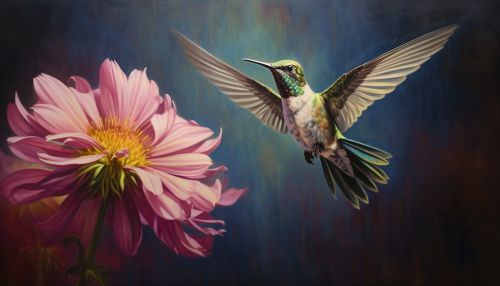Nectarivore
Introduction
A Nectarivore is an animal that primarily feeds on the nectar of plants. This diet is known as nectarivory. Nectarivores can be found in various animal groups including birds, insects, and mammals. These organisms play a crucial role in pollination, a process that is vital for the reproduction of many plant species.
Characteristics of Nectarivores
Nectarivores have evolved a range of physical characteristics and behaviors that enable them to efficiently extract nectar from plants. These adaptations vary depending on the species and their specific ecological niche.
Morphological Adaptations


Nectarivores often exhibit specialized morphological adaptations that assist in nectar feeding. For example, many nectarivorous birds such as hummingbirds and sunbirds have long, slender beaks and extendable tongues which allow them to reach the nectar deep within flowers. Similarly, nectarivorous bats, like the lesser long-nosed bat, have elongated snouts and tongues. Insects, such as butterflies and moths, have a long, tubular mouthpart called a proboscis, which they use to suck up nectar.
Behavioral Adaptations
Nectarivores also display behavioral adaptations that enhance their ability to feed on nectar. Many nectarivorous birds are capable of hovering in front of flowers, which allows them to feed without having to land. This is particularly evident in hummingbirds, which are known for their ability to hover and even fly backwards. Nectarivorous bats, on the other hand, typically feed while hanging from a perch or while in flight.
Nectarivory and Pollination
Nectarivores play a significant role in the process of pollination. As they feed on nectar, pollen from the flower's anthers sticks to their bodies. When the nectarivore visits the next flower, some of this pollen is transferred to the flower's stigma, resulting in pollination. This mutualistic relationship benefits both the nectarivore, which gains a food source, and the plant, which is able to reproduce.
Nectarivorous Species
There are numerous species across different animal groups that exhibit nectarivory. Some of the most well-known nectarivores include hummingbirds, sunbirds, honeyeaters, and various species of butterflies, moths, and bees. However, nectarivory is not limited to these groups. Certain species of bats, such as the lesser long-nosed bat and the Mexican long-tongued bat, are also nectarivores, as are some marsupials, such as the honey possum.
Impact on Ecosystem
Nectarivores have a significant impact on their ecosystems. Their role in pollination helps to maintain biodiversity by aiding in the reproduction of a wide variety of plant species. This, in turn, supports other species that rely on these plants for food and habitat. Additionally, nectarivores can influence the evolution of the plants they pollinate, as plants may evolve specific traits, such as flower shape and color, to attract certain pollinators.
Threats and Conservation
Like many animal groups, nectarivores face various threats, including habitat loss, climate change, and the introduction of invasive species. These threats can impact nectarivore populations directly, by reducing the availability of food and nesting sites, or indirectly, by disrupting the delicate balance of the ecosystems in which they live. Conservation efforts for nectarivores typically involve habitat preservation and restoration, as well as public education about the importance of these species and their role in the ecosystem.
